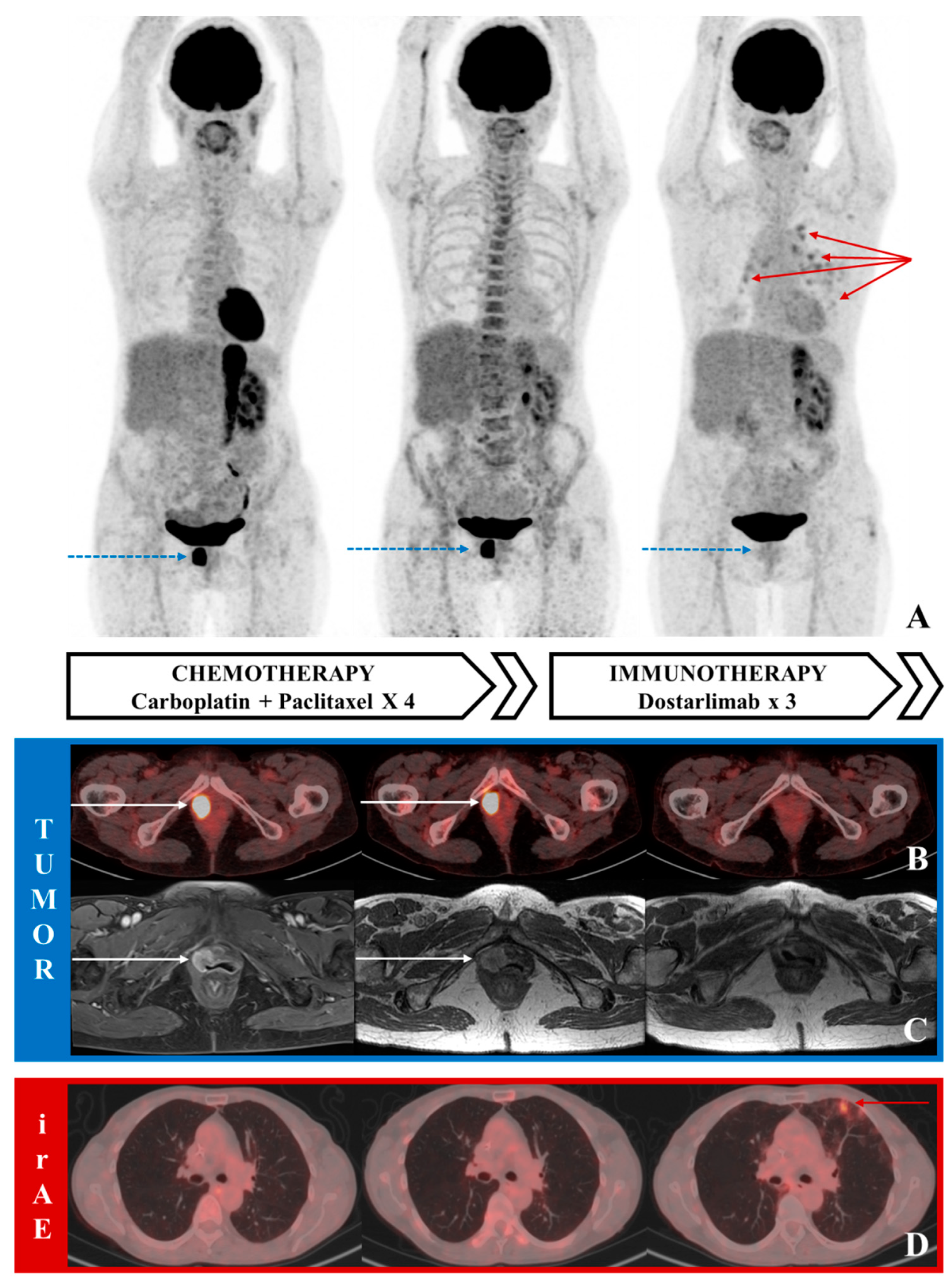18F-FDG PET/CT in Relapsed Endometrial Cancer Treated with Preoperative PD-1 Inhibitor Dostarlimab
Abstract
:Author Contributions
Funding
Institutional Review Board Statement
Informed Consent Statement
Data Availability Statement
Conflicts of Interest
References
- Decazes, P.; Bohn, P. Immunotherapy by Immune Checkpoint Inhibitors and Nuclear Medicine Imaging: Current and Future Applications. Cancers 2020, 12, 371. [Google Scholar] [CrossRef] [PubMed] [Green Version]
- Leon-Mateos, L.; Garcia-Velloso, M.J.; García-Figueiras, R.; Rodriguez-Moreno, J.F.; Vercher-Conejero, J.L.; Sánchez, M.; Perez Gracia, J.L.; Simo-Perdigo, M.; Gorospe, L. A Multidisciplinary Consensus on the Morphological and Functional Responses to Immunotherapy Treatment. Clin. Transl. Oncol. 2021, 23, 434–449. [Google Scholar] [CrossRef] [PubMed]
- Markham, A. Dostarlimab: First Approval. Drugs 2021. [Google Scholar] [CrossRef]
- Kasherman, L.; Ahrari, S.; Lheureux, S. Dostarlimab in the Treatment of Recurrent or Primary Advanced Endometrial Cancer. Future Oncol. 2021, 17, 877–892. [Google Scholar] [CrossRef] [PubMed]
- Oaknin, A.; Tinker, A.V.; Gilbert, L.; Samouëlian, V.; Mathews, C.; Brown, J.; Barretina-Ginesta, M.-P.; Moreno, V.; Gravina, A.; Abdeddaim, C.; et al. Clinical Activity and Safety of the Anti-Programmed Death 1 Monoclonal Antibody Dostarlimab for Patients With Recurrent or Advanced Mismatch Repair-Deficient Endometrial Cancer: A Nonrandomized Phase 1 Clinical Trial. JAMA Oncol. 2020, 6, 1766–1772. [Google Scholar] [CrossRef] [PubMed]
- Green, A.K.; Feinberg, J.; Makker, V. A Review of Immune Checkpoint Blockade Therapy in Endometrial Cancer. Am. Soc. Clin. Oncol. Educ. Book 2020, 40, 238–244. [Google Scholar] [CrossRef] [PubMed]
- Rubio-Pérez, J.; Hernández, R.; Hernández, T.; Doger, B.; Casado, V.; Moreno, V. Dostarlimab for the Treatment of Endometrium Cancer and Other Solid Tumors. Drugs Today 2021, 57, 187–197. [Google Scholar] [CrossRef] [PubMed]
- Galienne, M.; Rodrigues, M. Nouvelle AMM: Dostarlimab—Cancer de l’endomètre En Deuxième Ligne DMMR/MSI. Bull. Cancer 2021. [Google Scholar] [CrossRef] [PubMed]

Publisher’s Note: MDPI stays neutral with regard to jurisdictional claims in published maps and institutional affiliations. |
© 2021 by the authors. Licensee MDPI, Basel, Switzerland. This article is an open access article distributed under the terms and conditions of the Creative Commons Attribution (CC BY) license (https://creativecommons.org/licenses/by/4.0/).
Share and Cite
Seban, R.-D.; Donnadieu, A.; Journo, G.; Bidard, F.-C.; Richard, C.; Rouzier, R.; Champion, L. 18F-FDG PET/CT in Relapsed Endometrial Cancer Treated with Preoperative PD-1 Inhibitor Dostarlimab. Diagnostics 2021, 11, 1353. https://doi.org/10.3390/diagnostics11081353
Seban R-D, Donnadieu A, Journo G, Bidard F-C, Richard C, Rouzier R, Champion L. 18F-FDG PET/CT in Relapsed Endometrial Cancer Treated with Preoperative PD-1 Inhibitor Dostarlimab. Diagnostics. 2021; 11(8):1353. https://doi.org/10.3390/diagnostics11081353
Chicago/Turabian StyleSeban, Romain-David, Anne Donnadieu, Gabrielle Journo, Francois-Clement Bidard, Capucine Richard, Roman Rouzier, and Laurence Champion. 2021. "18F-FDG PET/CT in Relapsed Endometrial Cancer Treated with Preoperative PD-1 Inhibitor Dostarlimab" Diagnostics 11, no. 8: 1353. https://doi.org/10.3390/diagnostics11081353
APA StyleSeban, R.-D., Donnadieu, A., Journo, G., Bidard, F.-C., Richard, C., Rouzier, R., & Champion, L. (2021). 18F-FDG PET/CT in Relapsed Endometrial Cancer Treated with Preoperative PD-1 Inhibitor Dostarlimab. Diagnostics, 11(8), 1353. https://doi.org/10.3390/diagnostics11081353





